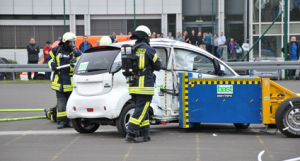Passive safety for electric vehicles

Electric vehicles (EV) that implement lithium-ion battery technology have recently entered the market and will pose high power and safety challenges. Accident analyses cannot be conducted until sufficient EVs are involved in crashes and are reported in crash databases. Until such data exist, researchers must use other research methods to understand and predict potential problems.
Background and objectives
The EVERSAFE (Everyday Safety for Electric Vehicles) project was born from the desire to provide safety requirements for electrically propelled vehicles, thus answering the current need for standardisation within this area. The Swedish-German project ran from 2012 to 2014. It addressed both active and passive safety issues.
Fraunhofer ICT and Fraunhofer EMI have both been involved in the EVERSAFE project. Both institutes are members of the Fraunhofer Battery Alliance, which is the portal to the research and service activities of the Fraunhofer-Gesellschaft in the field of energy storage systems.
Passive safety studies and battery safety
The passive safety activities in the EVERSAFE project focused on issues within the fields of crash compatibility and energy storage system (ESS) behaviour under and after crash loads. There was also an effort to develop concepts for safety regulations, post-crash safety handling and testing of electric vehicles.
The layout of vehicle components is sensitive to the mechanical loading expected in collisions. A review of the distribution of crash types involving high acceleration or high deformations was compiled to establish relevant load cases. Specific queries of databases to identify traction battery incidents were also conducted. An finite element model of an electric vehicle was developed together with its critical sub-components. The load cases identified from real world collisions were used in simulations to establish critical conditions for the energy storage system which are not fully addressed in current regulations and standards.
The outcomes of the simulation activities served as a basis for experimental tests with ESSs and their components, as well as the whole vehicle. Chemical analyses of the battery components identified the potential processes that can lead to emissions of flammable or toxic gases. These chemicals are released when the battery temperatures are too high and can develop if mechanical loading causes an internal short circuit or an external heat source affects the battery. There are several harmful chemicals contained in battery electrolytes, and hydrofluoric acid appears to be the most relevant gas to monitor. For the conditions tested, only severe deformations at the cell level caused a compromise of the battery safety. The battery lithium-ion cells evaluated in the project (currently used in automotive high-voltage batteries) have been proven to be more resistant to abuse than initially expected, indicating that current standards for electric vehicle components have already reached high safety levels. This conclusion holds from the point of view of mechanical loading, as well as from an electrochemical perspective, since both these issues were under analysis for the majority of the experiments.
Full scale crash tests demonstrated the high safety levels of all systems, even for more severe tests than those the vehicle is required to meet by legislation. Neither a side impact nor a rear/front multiple impact could provoke thermal activity or hazardous emissions from the battery in a Mitsubishi iMiEV or a BMW i3. These results can be used to promote consumer trust in the technologies.
New safety requirements and future research on passive safety
It is important that rescue crews are able to quickly identify and tackle any threats that might arise in a post-crash situation. The majority of rescue guidelines existing today for electrified vehicles are based on those existing for their ICE (internal combustion engine) counterparts. In light of the project findings, such guidelines were reviewed in an effort to pinpoint possible needs for improvement to the latter when the focus shifts to EVs. This leads to the creation of an updated set of guidelines which can be used as a replacement or complement to the ones existing today. Suggestions for updates to the United Nations Economic Commission for Europe’s vehicle regulations (94/95) are also suggested in order to handle the measurement of toxic/flammable gases in addition to liquid electrolyte in crash tests. Furthermore, recommendations for standards on identification and location of service disconnects for traction (high-voltage) power systems are suggested, carrying some improvement of post-crash handling.
A complete documentation of the project is available at www.eversafe-project.eu/.
Dr Jens Tübke
Spokesperson for the Alliance
Fraunhofer Battery Alliance
Tel +49 721 4640-343
[email protected]
www.batterien.fraunhofer.de
